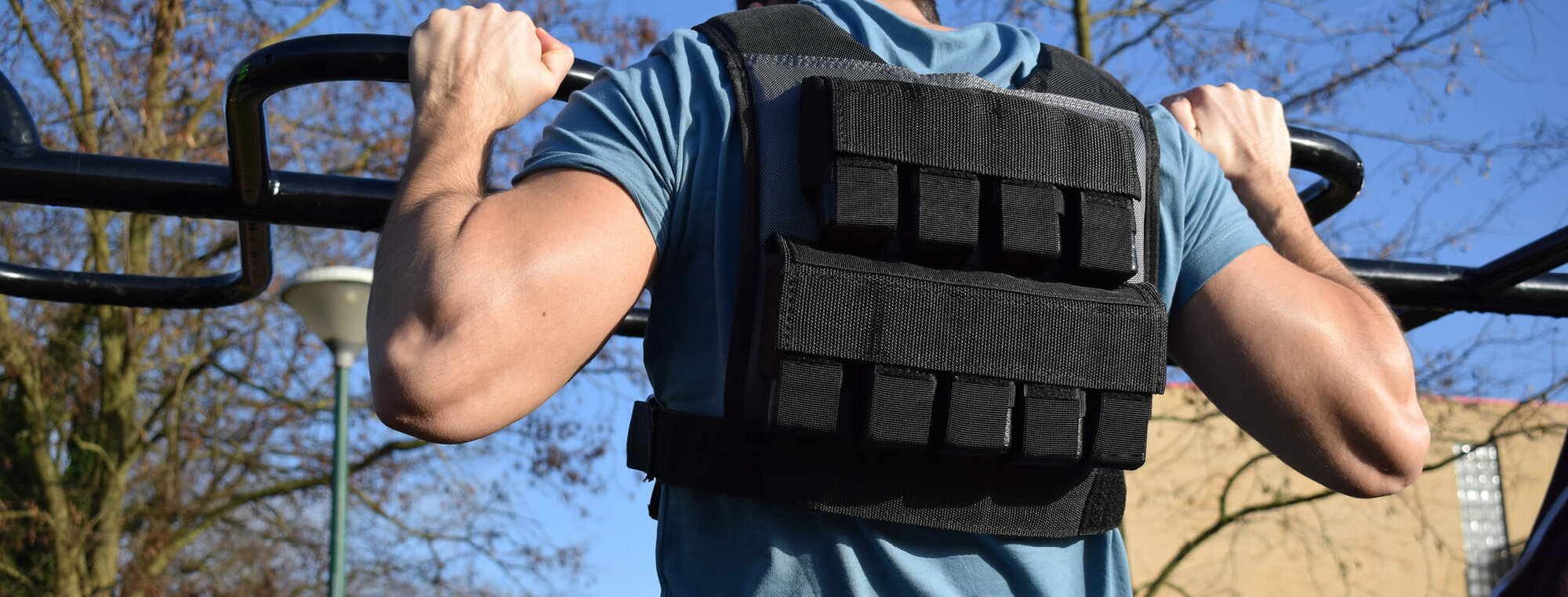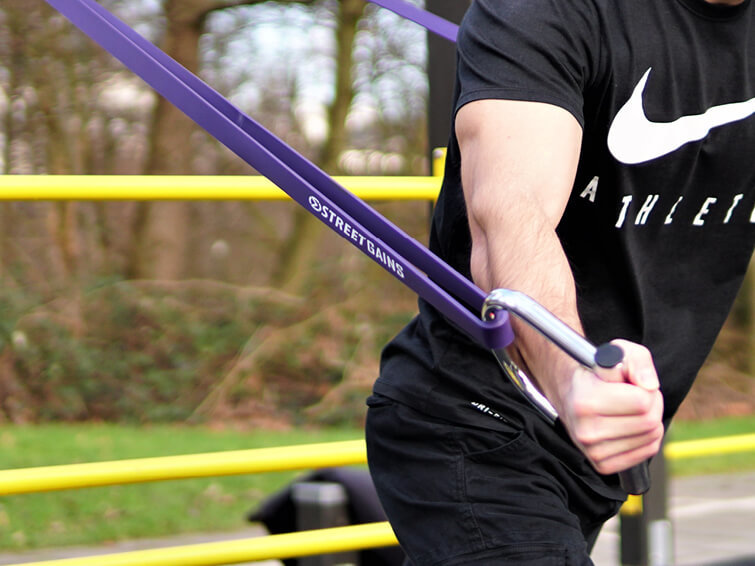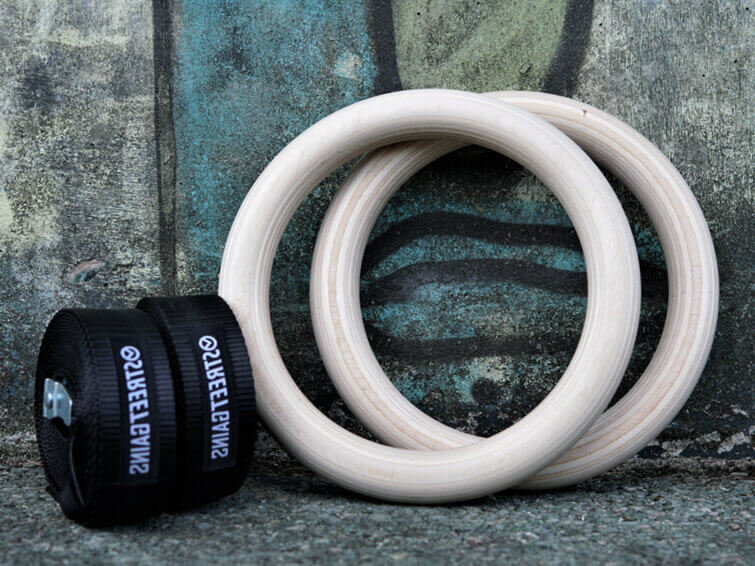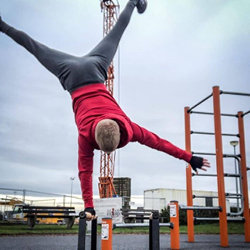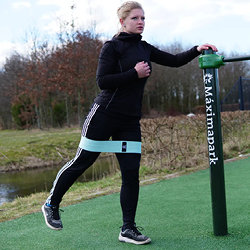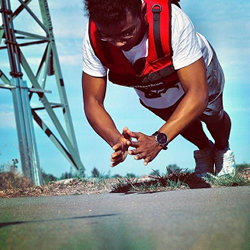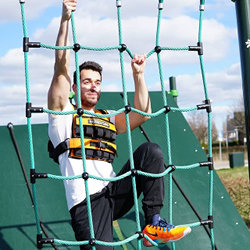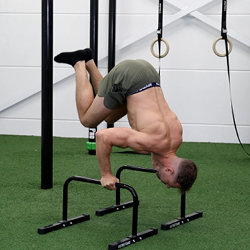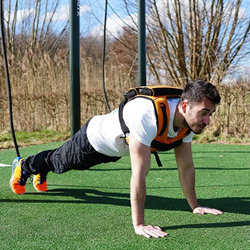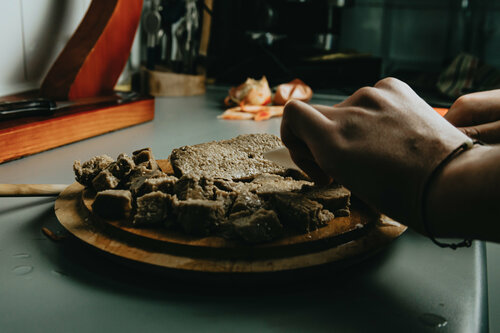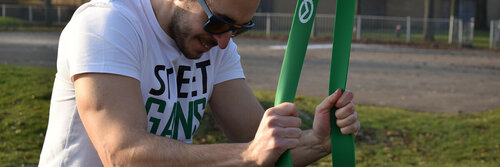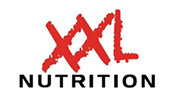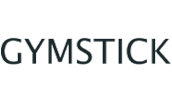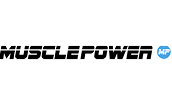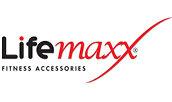Calisthenics is a popular form of exercise that appeals to many people because of the versatility and effectiveness of the exercises. But to get the most out of your calisthenics workouts, it is important to also pay attention to your diet. In this blog article, we discuss how to combine your calisthenics and nutrition for the best results. Proteins: Proteins are the building blocks of muscles and essential for muscle building. It is important to include enough protein foods in your diet, such as chicken, fish, eggs, and plant-based alternatives such as beans and tofu. This will help your muscles to recover and build new muscle mass. Fiber: Fiber is important for healthy digestion and maintaining a healthy weight. Try to include enough fiber-rich foods in your diet, such as vegetables, fruits, whole grains and nuts. Healthy fats: Healthy fats are important for your brain and heart health. Try to find healthy fats in foods such as avocados, nuts, seeds, and oily fish. Hydration: Hydration is important for the performance of your muscles and the reduction of muscle soreness after exercise. Make sure you drink enough water and avoid sugary drinks. Timing of meals: It is important to take your meals on time to ensure that you have enough energy during your workouts. Try to plan your meals so that you have enough time to absorb them before you start exercising. In conclusion, a healthy and varied diet is an important part of getting the most out of your calisthenics workouts. Try to include enough protein, fiber, healthy fats, adequate hydration and proper timing of your meals in your diet for best results.
Lees meer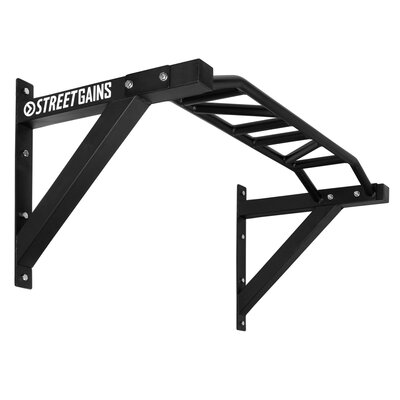
Robust pull-up bar with many handles for indoor and outdoor use.
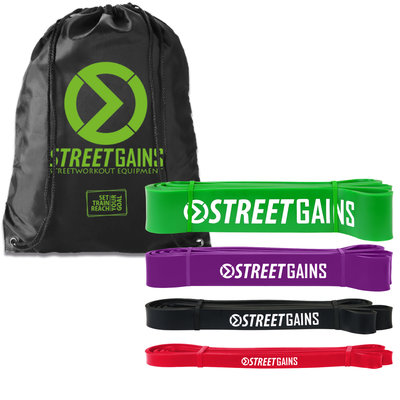
Set consists of four Resistance Bands that help you learn the muscle-up.
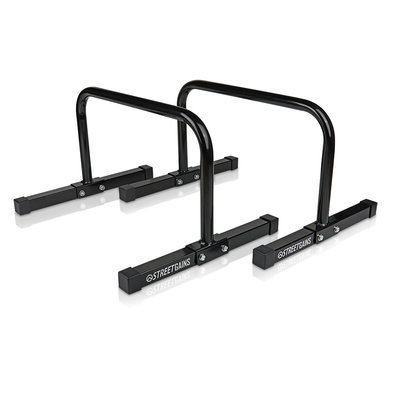
The parallettes have an indestructible steel construction and are equipped with non-slip pads.
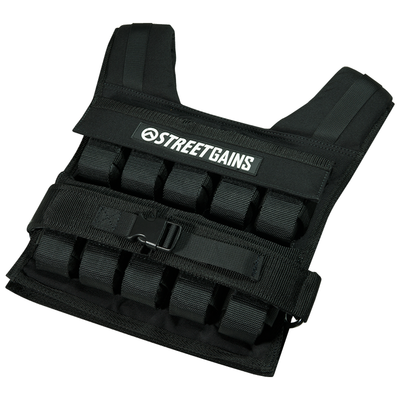
Compact weight vest made of heavy-duty CORDURA® nylon and with an adjustable weight up to 20 kg.
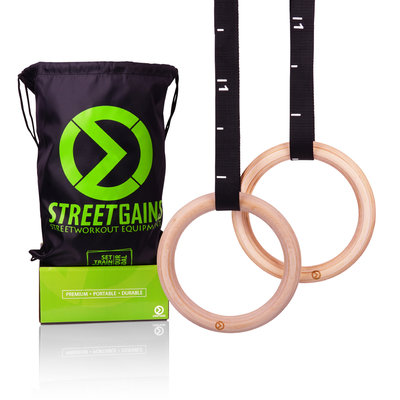
Premium wooden gymnastic rings made according to the requirements of tje FIG.
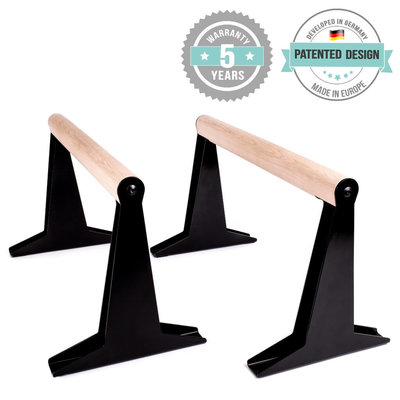
The ergonomic wooden handle of the medium high parallettes offers a perfect grip during training.
About StreetGains
The number 1 calisthenics store in Europe
StreetGains is the online store specialized in calisthenics and bodyweight fitness. A place where you can get all your calisthenics equipment, a place focused on you. With our products we hope to bring more possibilities, variations and challenges to your workout, so that maximum results and pleasure can be achieved. This to help you to come closer to your personal sports goals. Whether you are young or old, beginner or expert: with the help of StreetGains gear everyone can do it! #ReachYourGoal
What is calisthenics?
Calisthenics is a form of sports in which you use your own body weight as resistance. A sport that has grown enormously in popularity in Europe the past few year. The purpose of calisthenics is to increase muscle mass, strength, mobility, flexibility and endurance. Well-known exercises are: pull-ups, push-ups and dips. Calisthenics is usually performed outside. This allows you to meet new people and learn from each other exercises that you have not seen before. You inspire and motivate each other, so that it remains fun and challenging.
Calisthenics equipment for all levels
StreetGains supplies the right equipment for every level of athlete. Beginners often have the need for ways to ease exercises. For this level of athlete, a resistance band can be a perfect solution. These bands can make a heavy exercise, such as the pull-up, a lot easier. On the other hand, advanced athletes look for new variations and challenges to add to their workout. In this case, rings or a weight vest can be a necessary addition. We also have a wide range of parallelettes, chin-up bars, speed ropes, chalk and a lot more!
Always stay informed?
Subscribe for our newsletter.
Latest blog posts
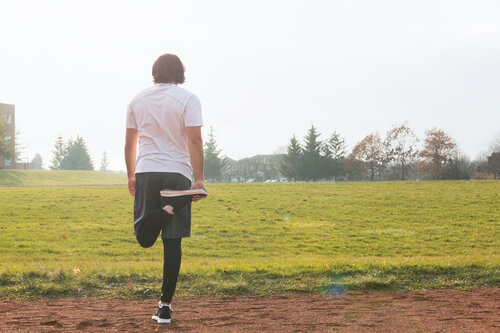
A calisthenics warm-up is important to prevent injury and to prepare the body for the efforts ahead. A good warm-up consists of a combination of cardio and stretching, and should take about 10 to 15 minutes. Start with a light cardio exercise such as jumping jacks or a brisk walk. This will increase the heart rate and improve blood circulation, warming the muscles and getting more oxygen. Static stretching You can then stretch your muscles through static stretching. Hold each stretch for about 15-30 seconds. Focus especially on the muscles that you will work during your calisthenics workout, such as the chest, back, shoulders, hamstrings and quadriceps. Here are some examples of static stretching suitable for a calisthenics warm-up: Hamstring stretch: Sit on the floor with your legs stretched out in front of you. Bend your upper body towards your knees and hold this position for about 15-30 seconds. Quad stretch: Stand up straight and hold one leg behind you with your hand. Hold this pose for about 15-30 seconds and repeat for the other leg. Chest stretch: Stand with your feet shoulder-width apart and extend your arms behind you. Press your chest forward and hold this position for about 15-30 seconds. Hip flexor stretch: Get on one knee and keep the other leg extended out in front of you. Push your hip forward and hold this position for about 15-30 seconds. Repeat for the other leg. Shoulder stretch: Grab one arm at the elbow and pull it to the opposite side of your body. Hold this pose for about 15-30 seconds and repeat for the other arm. Dynamic stretching Another way to stretch is dynamic stretching. It is widely used in calisthenics because it actively stretches and strengthens the muscles. This improves performance during exercises and reduces the risk of injuries. Dynamic stretching consists of movements that are smooth and fluid, in which the muscles are in continuous motion. It differs from static stretching, which stretches muscles by holding them in a fixed position. Some examples of dynamic stretching for calisthenics are: head to knee stretches, knee pushups, leg shakes, arm and back swings, and knee bends. It is important to perform these movements in a controlled manner and to start with a low intensity to avoid injuries. Don't forget the cool down A warm-up is important for any workout, but it's even more important for calisthenics, which use your own body weight. By ensuring a good warm-up, you reduce the risk of injury and increase the effectiveness of your workout. Don't forget to stretch and cool down after your workout as well. This will help your muscles recover and prevent them from getting stiff.
Lees meer
Calisthenics, bodyweight training or streetworkout is a form of sports where you use your own body weight as resistance. The goal of calisthenics is to increase muscle mass, strength, mobility, flexibility and endurance. Well-known exercises are pull-ups, push-ups and dips. Usually sports are done outside in parks or playgrounds. In the Netherlands there are more and more places to find special calisthenics parks. Is this not available in your area? Then be creative and make use of the environment. Furthermore, calisthenics is a very social sport. Because you exercise outside, you meet new people and learn from each other exercises that you have not seen before. You inspire and motivate each other, making it fun and challenging. Calisthenics is suitable for everyone. Whether you are young or old, beginner or expert. Where does calisthenics come from? Like many good things in life, calisthenics also originated in Greece. The word calisthenics is made up of the two Greek words "kallos", meaning beautiful, and "sthenos", meaning strength, both physical and mental. Calisthenics was part of the training of soldiers in training for the Spartan elite army. With exercises such as lunges, jumping jacks, sit-ups, pull-ups, squats and dips they were prepared for this army. Calisthenics exercises The different calisthenics exercises can be roughly divided into three categories: static postures, repetitions and freestyle. Static holds Back Lever Front Lever Planche Plank Handstand Reps Push-Up Pull-Up Muscle-Up Squat Dip Sit-Up Freestyle Calisthenics also has a show element, freestyle. During a freestyle there is the chance to show creativity and explosiveness. Different static postures are combined with each other and the athlete jumps between and over the bars, to make it look like a fluid whole. During a freestyle, movements from other sports are also implemented, such as freerunning or gymnastics. All this to make it the most spectacular show possible. Calisthenics competitions Various calisthenics competitions are organized nationally and internationally. These are events where it is not only fun to participate, but also very impressive to be present as a visitor. Street workout competitions generally consist of two parts. Freestyle and strict form battles. The strict form part is about who is able to do the most repetitions of a certain exercise with a perfect execution. In general, these are pull-ups, muscle-ups, push-ups and dips. The second part of a calisthenics competition is the freestyle part. Participants are judged on dynamics, static postures and combos. In addition, the jury also awards points for the presentation and interaction with the spectators. Calisthenics Association Calisthenics has grown so quickly in recent years that a calisthenics association was founded in 2016. The Dutch Calisthenics Association (NLCB), part of KrachtsportNL. You can go to the Dutch Calisthenics Association for, among other things, following workshops, courses, education and registering for a competition.
Lees meer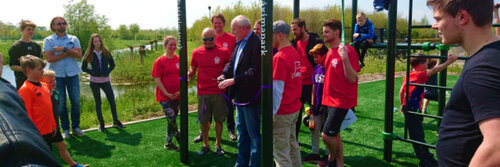
It took a while but then you really have something. The sporty Maximapark now also has a calisthenics and boot camp park. The park on the Ribbon was created on the initiative of five Leidsche Rijners. The official opening took place last Saturday and we were there! The program Alderman Kees Geldof was also present and was allowed to cut the red ribbon. After the official opening of the streetworkout park, the Calisthenics Zeist team gave an impressive demo and showed the possibilities of the park. Then the audience could work up a sweat. Two competitions were held. Who could hang around the bars the longest and who could perform the most push-ups. The price? A bright green goody bag from StreetGains :). To conclude, an interesting calisthenics workshop could be followed, provided by Papito, Thijmen and Bo from Calisthenics Zeist. Calisthenics training in the Maximapark The streetworkout park is very active and various training sessions are regularly organized. For example, if there are sufficient registrations, calisthenics training takes place on Mondays. You decide for yourself what you think the training is worth and want to pay for (pay what you want principle). Visit the Facebook-page of Calisthenics Utrecht Leidsche Rijn for more information or to register for a training.
Lees meer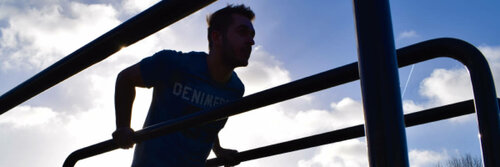
In this article we share two calisthenics schedules especially for the novice calisthenics athlete. This is a follow-up to our previous blog post 'how to: starting with calisthenics'. In it we discussed how to start with calisthenics and what the five basic exercises are. In this article we will explain how to incorporate these basic exercises into a good training schedule. We therefore recommend that you first read the 'how to: start with calisthenics' before starting this article. Calisthenics Beginner Schedule # 1 The first calisthenics schedule is a fun and challenging schedule that is different from most schedules. The idea behind this schedule is that you start with a difficult variant of an exercise. You perform this as often as possible without taking a break. When you have given everything and can no longer perform repetitions, you switch to the easier version of the exercise. The diagram shows that you start with the normal push-up (on all fours) and then switch to knee push-ups. Exercise Repetitions Sets Resistance Band Pull-ups Max 1 Australian Pull-ups Max 1 Push-ups Max 1 Knee Pus-ups Max 1 Bench Pistol Squats Max 1 Squats Max 1 (Tucked) L-Sit Hold Max 1 (Tucked) L-Sit Raises Max 1 Dips Max 1 Bench Dips Max 1 Calisthenics Beginner Schedule # 2 The second calisthenics schedule is a more traditional training schedule. It contains five exercises. You perform three sets of each exercise. Rest for approximately two minutes between each set. Exercise Repetitions Sets Australian Pull-ups 12 3 Push-ups 10 3 Bench Pistol Squats 10 3 Bench Dips 15 3 (Tucked) L-Sit Raises 12 3
Lees meerHave you just started or are you thinking about starting calisthenics? Are you looking for a good beginner workout? We have added this article to our calisthenics blog especially for you. In this article we will explain, among other things, which exercises you can start with, how to master these exercises and what you should consider further. The purpose of the 'How To: start with calisthenics' is to lay a solid foundation, by mastering the basic exercises of calisthenics. Only when you have mastered these well, you can focus on the more advanced calisthenics exercises, such as the muscle-ups and handstand push-up. Before you start with calisthenics When you are just starting out with calisthenics, it is important to build it up slowly and not to rush. Your muscles, tendons and the rest of your body have to get used to the new load. In addition, it is always important to start every workout with a good warm-up. During the warm-up it is important to warm up the muscles and tendons and to get the blood circulation going. So don't skip this. A good warm-up will have a positive effect on your strength and endurance during the rest of your workout. A skipping rope can help with this. We recommend the Speed Rope Survival. The steel ball bearing system makes the skipping rope run smoother and faster than an ordinary skipping rope. It is not for nothing that martial artists use this during their strength and conditioning training. The five basic exercises of calisthenics Always remember that it is important to exercise your entire body, including your legs! In this workout, attention is therefore paid to each body part: back, chest, shoulders, arms, core and legs. The calisthenics beginner workout consists of the five basic calisthenics exercises, namely push-ups, pull-ups, dips, pistol squats and L-sits. Make sure you have mastered each step before starting the next step. 1. The push-up We start with push-ups, or push-ups. It is perhaps the most famous of the five basic exercises we will go through in this article. The push-up mainly requires strength from the chest, shoulders and triceps. Step 1: Knee push-ups The first step to master the push-up is to perform knee push-ups. Get on your knees and place both hands shoulder-width apart on the floor. This is the starting position. Now slowly sink down until your chest almost touches the floor. Then press up again to the starting position. Make sure your body stays still throughout the exercise and you only move your arms. You can use these push-up supports to relieve your wrists. Step 2: Incline push-ups When the knee push-ups are easy for you, you can proceed to the incline push-ups. To do this, find an object that is higher than the ground. For example a wall, staircase or bench. We use a rod in the example photo below. Stand up straight and place your hands on the chosen object. Keep your body in a straight line and slowly sink down. Then press up again. Start with a relatively high object and slowly work your way up to a lower object until you don't need an object at all. 2. The pull-up The pull-up, also called a pull-up, is an excellent exercise to target the back muscles and biceps. It is an exercise that requires a lot of strength. It may therefore take a while before you master it. So don't give up right away and perform the following steps as best you can. Only then will you succeed! Step 1: Australian pull-ups We start with the Australian pull-ups. This variant of the pull-up is an excellent way to work towards the pull-up. With your back pointing to the floor, hang under a horizontal bar. Just like you can see in the picture below. Grasp the bar slightly wider than shoulder width. This is the starting position. Draw your chest towards the bar. Then slowly lower back to the starting position. The lower the bar you use, the more difficult the exercise will be. Tighten your abs during this exercise and make sure your body is in a straight line. Step 2: Australian pull-ups small/wide grip We stick with the Australian pull-ups for a while, but now switch grip positions. Stand in the same position as in the first step, but hold the bar very wide or very narrow. Step 3: Resistance band pull-ups In this step we are going to use resistance bands. The Pull-Up Pack to be precise. This is a specially composed package that will help you perform the perfect pull-up step by step. The package consists of three resistance bands, each with a different resistance. Attach the band to a high bar. Then step on the band with both feet and grasp the bar with your hands. Pull yourself up slowly and in a controlled manner. Hold this position for one second and then slowly lower yourself back down. You start with the strongest tire in the package and work towards the lightest tire. When you can do a few reps with the lightest band, it's time to do the pull-up unassisted. 3. The dip The third basic calisthenics exercise is the dip. You usually perform dips on two parallel bars, but you can also use, for example, two chairs. Make sure that they are sturdy and stable. Dips are an excellent exercise for your triceps and chest muscles. Step 1: Behind the back dips First, find a chair, staircase or bench on which you can perform the 'behind the back dips'. With both hands behind your back, put your palms on the object, just like in the photo below. Now slowly sink down to the point that your elbows are at a ninety degree angle. Only use your arms and keep the rest of your body still. Now push yourself back up, so that you get back to the starting position. Step 2: Behind the back dips with elevated legs This exercise is a challenging variation of the first step. You perform the 'behind the back dips' again, but now you put your legs on an elevation. Step 3: Negative dips Time for the real work! Stand between two parallel bars. You can use the Adjustable Equalizer for this. Put your hands on the bars. Jump up so that both feet are off the ground and your full body weight is supported on your arms. This is the starting position. Now lower as slowly as you can until your elbow is at a ninety degree angle and your feet are touching the floor. Then jump up again so that you get to the starting position. You will likely drop down quickly and uncontrollably at first. The more you perform the exercise, the better. Finally, try to push off less and less hard when you want to get into the starting position. This is to use more power from your arms instead of your legs. 4. The pistol-squat We have come to the legs. Many find this the least enjoyable part of the body to train. Still, it is very important not to skip this. Exercising your legs ensures that more growth hormones and testosterone are released in the body. This stimulates muscle growth throughout the body. The pistol squat is a one leg squat. The other leg points straight forward, making the body look like a gun. Hence the name pistol squat. Step 1: Bench Squats We start easy. Find a playpen, chair or just a park bench. Stand in front of the object with your back to it. Put your feet shoulder width apart. This is the starting position. Now slowly bend your knees until you are sitting on the bench. Then you get up again so that you come back to the starting position. Make sure your knees are not too far over your toes and try to push from your heels as you squat. Find a lower and lower object until you can reach deep enough that your knees are at a ninety degree angle. Step 2: Explosive squats We are now removing the object from behind us. Squat down as deep as you can. Then jump up as explosively as possible, so that your feet are off the ground. As this improves, try to pull in your knees as you jump up. Step 3: Bench pistol-squats In this step we again use a bench, box or chair. Stand on one leg and extend the other leg in front of you. This is the starting position. Now squat slowly down until you are on the object. Go back up to the starting position. To maintain your balance, you can stretch your arms forward during this exercise. Step 4: Assisted pistol-squats Now get the object from behind you. Perform the pistol squat while supporting yourself with one arm on a pole or resistance band. Try to lean less and less on your arm and get more power out of your leg. Do this until it succeeds without additional support. 5. The L-sit The L-sit is a static position that you hold for a few seconds. Like the dips, you perform the L-sit on two parallel bars. You can use the Adjustable Equalizer for this again. The L-sit requires strength in the abdominal muscles, but your shoulders and arms must also be strong enough to hold the body weight. The name L-sit comes from the posture you adopt. It resembles the letter “L” from a side view. Step 1: Knee raises Stand between two parallel bars. Grab them with both hands and jump up. You have your legs hanging straight down and you rest on the bars with outstretched arms. This is the starting position. Bend your knees and bring your legs up slowly and controlled, to the point that they are parallel to the ground. Now lower your legs back to the starting position. Step 2: Tucked L-sit hold Do the first step again, but try to hold the legs at the top for a few seconds. Step 3: Leg raises Do the first step again, but instead of bending your knees, now keep your legs fully extended. Step 4: Single leg L-sit You are just one step away from a full L-sit. Assume the starting position, but with the legs out in front of you and your knees bent ninety degrees. Fully extend your left leg while keeping the other leg bent. Try to hold this position for as long as possible. If this is no longer possible, you switch legs. A set of Steel Parallettes can be useful for this exercise. De eerste stap is gezet. Je hebt de 'How To: starten met calisthenics' gelezen. Als het goed is ben je een stuk wijzer geworden en weet je wat je nu te doen staat. Tijd om te beginnen! Ga naar buiten (of binnen) en ga ervoor. Wil je weten hoe je deze oefeningen in een workout gebruikt? Lees dan het artikel: calisthenics beginner schema . Daarin geven wij je twee soorten beginner trainingsschema's, waarin je precies ziet hoeveel sets, reps en oefeningen je moet uitvoeren. Zet door en geef niet op totdat jouw doel bereikt is. #ReachYourGoal
Lees meer



